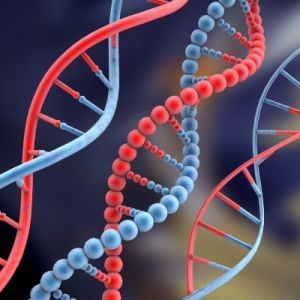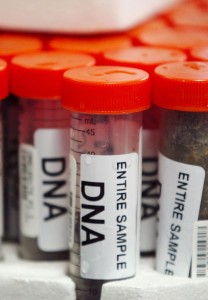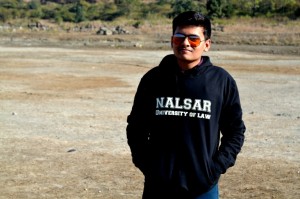In this blog post, Abhiraj Thakur, a 1st-year student of NALSAR University of Law, Hyderabad, writes about the DNA fingerprinting technology which is widely used to secure convictions. This technique being reliable and accurate should be adopted at full scale in India. However, our country still suffers from some issues which thwart the use of DNA fingerprinting in Indian Criminal Law.
What is DNA?
 DNA (Deoxyribonucleic Acid) is the primary hereditary material in a human body. The Human DNA has a double helix structure. Most of the DNA is found in Nucleus of the cell called the nuclear DNA, and some are found in mitochondria called the mitochondrial DNA (mtDNA). It complexes with proteins to form chromosomes which contain our genes and all genetic information.[1]
DNA (Deoxyribonucleic Acid) is the primary hereditary material in a human body. The Human DNA has a double helix structure. Most of the DNA is found in Nucleus of the cell called the nuclear DNA, and some are found in mitochondria called the mitochondrial DNA (mtDNA). It complexes with proteins to form chromosomes which contain our genes and all genetic information.[1]
The DNA Fingerprinting technology is one of the foremost and most reliable technologies used in USA and UK in identifying individual culprits through their respective unique DNA patterns. In 1984, Sir Alec Jeffreys, of UK discovered that no two people could have the same DNA sequence.[2] Although more than 99% of the DNA is the same in all humans, there are some particular strands that are unique between two individuals having the same sequence. Sir Jeffreys was the first person to discover this. This led to the birth of DNA Fingerprinting. The potential of DNA Fingerprinting in the investigation of crimes was quickly realized. In 1986, this method to solve the rape and murder mystery of a teenage girl Dawn Ashworth near Leicester. The suspect Richard Buckland was exonerated, and the real criminal Colin Pitchfork was found guilty. It was the first case in which DNA technology was used.[3]
Benefits
Accuracy
In a crime scene, there is always a possibility of finding the DNA of people other than the criminal. In such a scenario the, a majority of investigative agencies today rely on DNA fingerprinting to find out which DNA is that of the criminal. Also in cases where a mixture of a blood sample or other samples is found at the crime scene. DNA technology today has sufficiently evolved so that it can identify each of the blood of each from a mixed sample. This has greatly helped in securing convictions in rape cases. 
For example, if a girl is raped by, let say, six persons, DNA fingerprinting can identify the DNA sequence of every individual and comparing it with the suspects, we can catch the criminals. In such cases, each of the people whose DNA pattern matches with the sample gets convicted and of those whose DNA sample does not match is proved not guilty and acquitted.
Reliability
Today, There is greater acceptance of DNA evidence over Narco Analysis because DNA evidence does not lie. The narcotic analysis is a subjective method. A lot of subjectivity is there in it. It is possible for people to fool it. People can lie but DNA cannot. Earlier there were statistical doubts that two persons may have the same DNA sequence. But as the technology is advanced, it has now been proved that no two persons can have the same DNA sequence. Narco analysis is not always reliable and is not accepted as evidence by the courts.[4]
Apart from crimes, it is also extensively used for on- criminal purposes like paternity tests, seed stock identification, the authenticity of consumer products, and medical diagnosis.
Limitations
Identical or Monozygotic twins have the same DNA sequence. Therefore in such cases, the law enforcement agencies remain skeptical of relying on DNA fingerprinting to deal and identify the real criminal. Also, a question arises in regard to such twins, can they be convicted only by the DNA Evidence? This is the biggest limitation of DNA evidence. Two identical twins do have the same DNA. So in such case where one of them has committed a crime, they cannot be convicted by DNA evidence. But in such cases, the simple fingerprint will help to convict the real criminal. It is because there is a slight difference between the finger prints of the identical twins. But in the courts of law, full fingerprints only are acceptable because clever counsels raise questions on partial fingerprints as they can match with others.
Usage in India
DNA testing as evidence is not covered under Indian Evidence Act 1872 and Criminal Procedure Code 1973. The method of DNA profiling used today in India is based on polymerase chain reaction (PCR) and uses short tandem repeats (STR). These techniques have revolutionized the speed and efficiency of the DNA test. These techniques are very reliable and are in vogue in various countries. Dr. Lalji Singh is considered to be the “Father of DNA fingerprinting” in India, He developed and used the technology in India for the first time in 1988.
Problems with Usage in India
Handling of Samples
The admissibility of DNA evidence depends on upon accurate and proper collection, preservation and documentation which can satisfy the court. As was seen in the infamous OJ Simpson case, improper handling of DNA evidence can lead to the acquittal of the accused. The procedure of collection and preservation is very important. The sterile gloves and forceps must be used. If we use our hand in the collection process, our DNA will get mixed up with it.
Today in India the police constables are untrained in how to collect DNA samples. In foreign countries, when a crime occurs, first the forensic investigators and scientists go to the crime scene to collect forensic data. But here in India, first an untrained constable goes there. Acting on intuition, he washes up the body and removes it. He in this process destroys vital DNA evidence. So they must be trained to handle forensic evidence and to properly collect it and seal it. But even when there is some contamination, it can be found out in the test result; we can see a faint band of DNA of the person whose DNA has been mixed up and a strong band of DNA of the real criminal. But such contaminated evidence is not accepted as evidence in the courts.
Storage of Samples
In UK and US, the samples of DNA are stored in National DNA Database. The police have very limited powers to retain the DNA recovered from crime site; their job is confined to just collection and deposition. Unlike in India where the police have unchecked powers to collect and retain the DNA of suspects even after acquittal. This raises concerns about many over fears that it may lead to misuse of DNA database and may divulge the privacy of the individuals. Of suspects even after acquittal. 
DNA of all convicts should be stored in the database so that the multiple offenders can be apprehended easily. Moreover, in countries like the UK, the government is trying to create a database of all people, not just convicts and acquitted but also of other innocent people. The purpose of such databases is not just for crime investigation rather it will be helpful for research in medicine.
Lack of Test Centers
In foreign countries, there are enough facilities for the DNA testing. People can get DNA fingerprinting done anywhere as there are a lot of institutions. Even for something like $10000-$12000 they can do the full genome sequencing[5]. But in India, there are not many facilities. For doing a DNA, test people have to go all the way to Centre for Cellular and Molecular Biology or CCMB in Hyderabad. This may not be feasible for everyone. With due regard to the efficiency of this technology, there should be sub-branches of this institution in every district of the country. If not possible, it must be made sure that people from all parts of the country can readily have DNA testing.
Violation of Constitutional Rights
There have been quite many ethical concerns regarding DNA tests. Some people allege that it violates the right to privacy, right to life and right against self-incrimination according to Article 20 of Indian Constitution.
The most famous case involving the use of DNA fingerprinting in India is of ND Tiwari. ND Tiwari a famous politician was alleged by Rohit Shekhar to be his biological father. In the subsequent paternity case, many legal issues surrounding the DNA Testing emerged- such as if paternity is conclusively proved (100%) by DNA Testing, whether the persons have the right to keep the result of such tests private etc.
Indian law says that one cannot be forced against his/her will to give DNA evidence. But today in certain cases, courts are forcing suspects to undergo DNA tests. As in the ND Tiwari case, all these arguments were raised. But the court forced ND Tiwari to give his blood sample in the larger interest of the public. Courts can force people to give their blood samples to meet the demands of justice.
These are the few burning issues with the use of DNA printing technology in India. The future of DNA Technology is no doubt very bright. There has been a revolution with regards to the technology. In the time to come, it will prove very helpful in convictions of the offenders. There has already been rigorous research going on in the technology around the world; India shall by no means lack behind in it.
[divider]
Footnotes
[1] http://www.cdfd.org.in/servicespages/dnafingerprinting.html
[2] Ibid
[3] http://news.bbc.co.uk/2/hi/programmes/newsnight/8245312.stm
[4] Selvi & Ors. Vs. State of Karnataka & Anr. On 5 May 2010
[5] Full genome sequencing is a laboratory process that determines the complete DNA sequence of an organism’s (in this case human’s) genome at a single time.
 Serato DJ Crack 2025Serato DJ PRO Crack
Serato DJ Crack 2025Serato DJ PRO Crack










 Allow notifications
Allow notifications



“Indian law says that one cannot be forced against his/her will to give DNA evidence.”- In light of this statement in your report can you please clarify your stand on sec 53 (1) of CrPC where the term examination includes DNA profiling?